
Computer hardware and IT solutions company Dell (NYSE: DELL) reported Q2 CY2025 results topping the market’s revenue expectations, with sales up 19% year on year to $29.78 billion. On top of that, next quarter’s revenue guidance ($27 billion at the midpoint) was surprisingly good and 3.4% above what analysts were expecting. Its non-GAAP profit of $2.32 per share was 1.1% above analysts’ consensus estimates.
Is now the time to buy Dell? Find out by accessing our full research report, it’s free.
Dell (DELL) Q2 CY2025 Highlights:
- Revenue: $29.78 billion vs analyst estimates of $29.23 billion (19% year-on-year growth, 1.9% beat)
- Adjusted EPS: $2.32 vs analyst estimates of $2.29 (1.1% beat)
- The company lifted its revenue guidance for the full year to $107 billion at the midpoint from $103 billion, a 3.9% increase
- Management raised its full-year Adjusted EPS guidance to $9.55 at the midpoint, a 19.5% increase
- Operating Margin: 6%, in line with the same quarter last year
- Free Cash Flow Margin: 6.3%, up from 2.8% in the same quarter last year
- Market Capitalization: $89.62 billion
Company Overview
Founded by Michael Dell in his University of Texas dorm room in 1984 with just $1,000, Dell Technologies (NYSE: DELL) provides hardware, software, and services that help organizations build their IT infrastructure, manage cloud environments, and enable digital transformation.
Revenue Growth
A company’s long-term performance is an indicator of its overall quality. Any business can put up a good quarter or two, but the best consistently grow over the long haul.
With $101.5 billion in revenue over the past 12 months, Dell is a behemoth in the business services sector and benefits from economies of scale, giving it an edge in distribution. This also enables it to gain more leverage on its fixed costs than smaller competitors and the flexibility to offer lower prices. However, its scale is a double-edged sword because it’s challenging to maintain high growth rates when you’ve already captured a large portion of the addressable market. For Dell to boost its sales, it likely needs to adjust its prices, launch new offerings, or lean into foreign markets.
As you can see below, Dell’s 2.9% annualized revenue growth over the last five years was sluggish. This shows it failed to generate demand in any major way and is a rough starting point for our analysis.
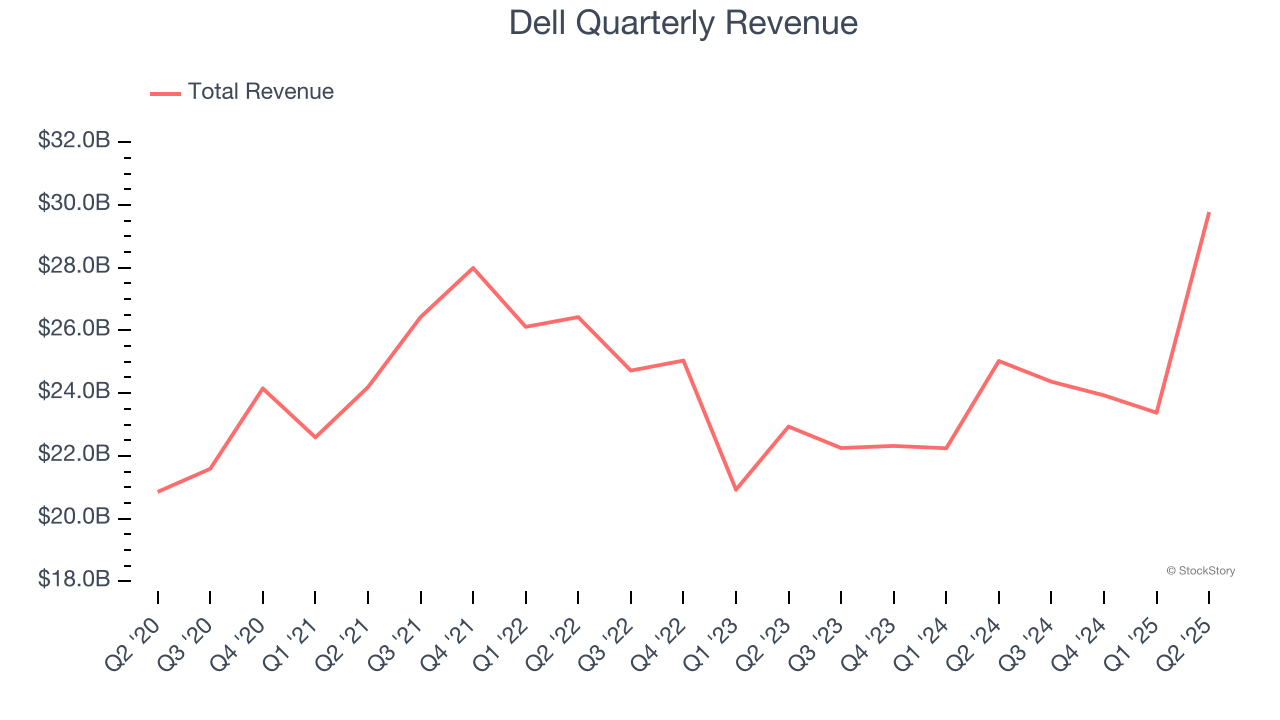
We at StockStory place the most emphasis on long-term growth, but within business services, a half-decade historical view may miss recent innovations or disruptive industry trends. Dell’s annualized revenue growth of 4.1% over the last two years is above its five-year trend, but we were still disappointed by the results. 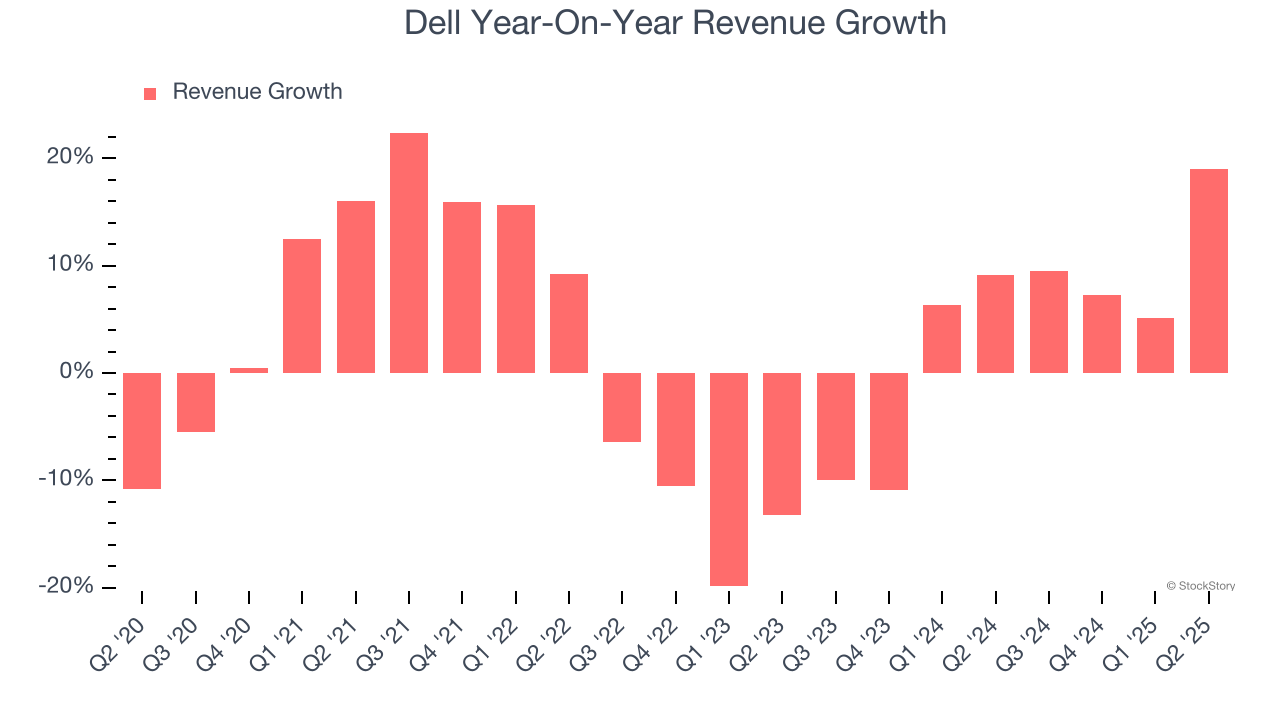
This quarter, Dell reported year-on-year revenue growth of 19%, and its $29.78 billion of revenue exceeded Wall Street’s estimates by 1.9%. Company management is currently guiding for a 10.8% year-on-year increase in sales next quarter.
Looking further ahead, sell-side analysts expect revenue to grow 5.3% over the next 12 months, similar to its two-year rate. This projection is above average for the sector and implies its newer products and services will spur better top-line performance.
Software is eating the world and there is virtually no industry left that has been untouched by it. That drives increasing demand for tools helping software developers do their jobs, whether it be monitoring critical cloud infrastructure, integrating audio and video functionality, or ensuring smooth content streaming. Click here to access a free report on our 3 favorite stocks to play this generational megatrend.
Operating Margin
Operating margin is an important measure of profitability as it shows the portion of revenue left after accounting for all core expenses – everything from the cost of goods sold to advertising and wages. It’s also useful for comparing profitability across companies with different levels of debt and tax rates because it excludes interest and taxes.
Dell was profitable over the last five years but held back by its large cost base. Its average operating margin of 5.6% was weak for a business services business.
On the plus side, Dell’s operating margin rose by 2 percentage points over the last five years, as its sales growth gave it operating leverage.
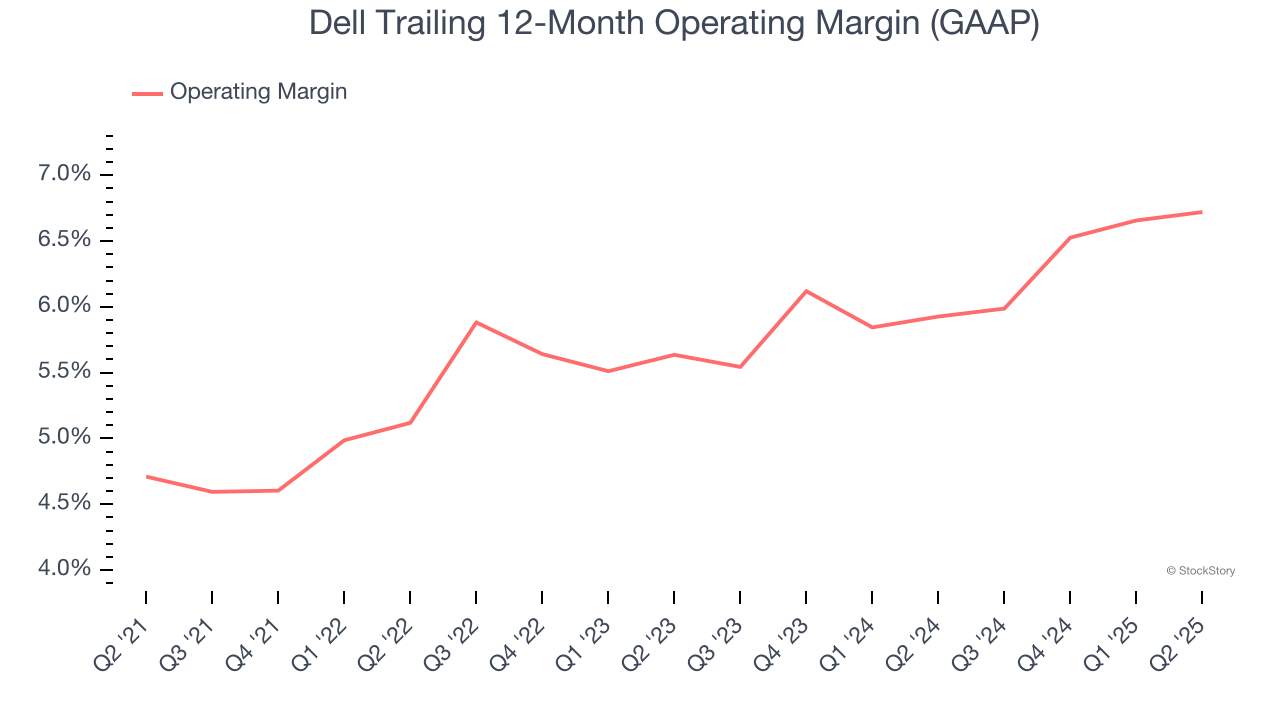
This quarter, Dell generated an operating margin profit margin of 6%, in line with the same quarter last year. This indicates the company’s overall cost structure has been relatively stable.
Earnings Per Share
Revenue trends explain a company’s historical growth, but the long-term change in earnings per share (EPS) points to the profitability of that growth – for example, a company could inflate its sales through excessive spending on advertising and promotions.
Dell’s EPS grew at a decent 7.8% compounded annual growth rate over the last five years, higher than its 2.9% annualized revenue growth. This tells us the company became more profitable on a per-share basis as it expanded.
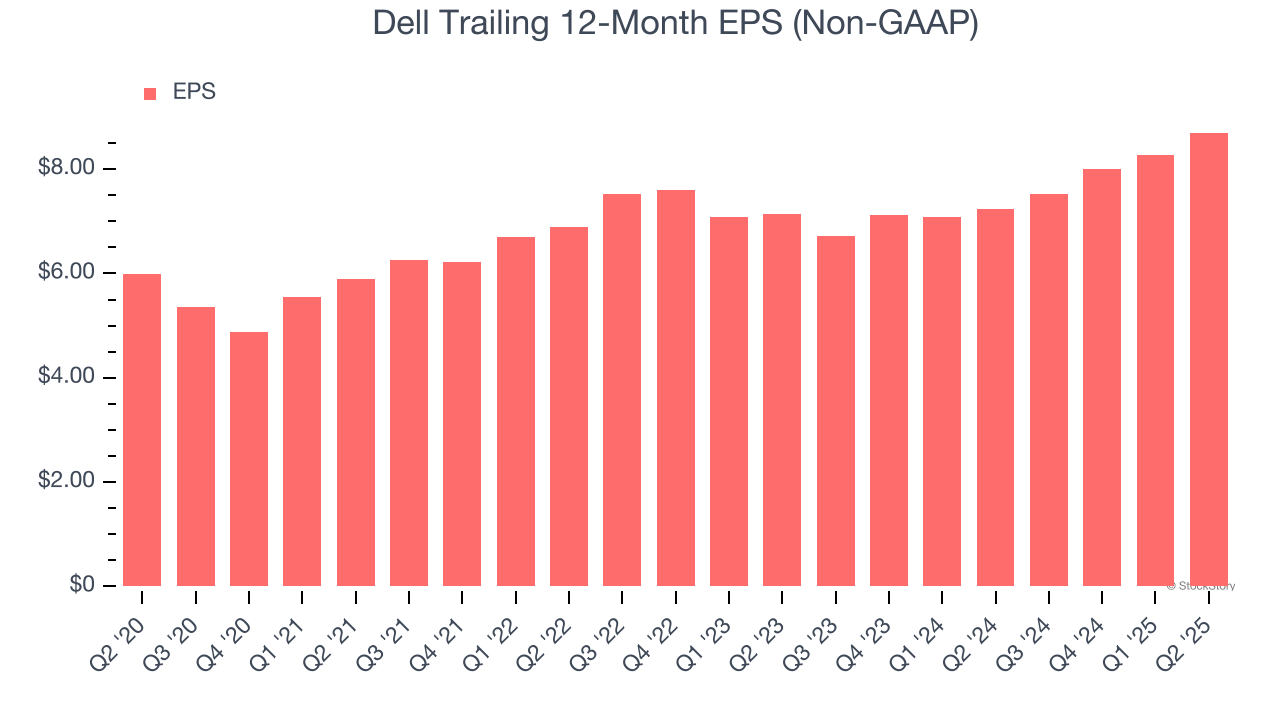
Diving into the nuances of Dell’s earnings can give us a better understanding of its performance. As we mentioned earlier, Dell’s operating margin was flat this quarter but expanded by 2 percentage points over the last five years. On top of that, its share count shrank by 10.1%. These are positive signs for shareholders because improving profitability and share buybacks turbocharge EPS growth relative to revenue growth. 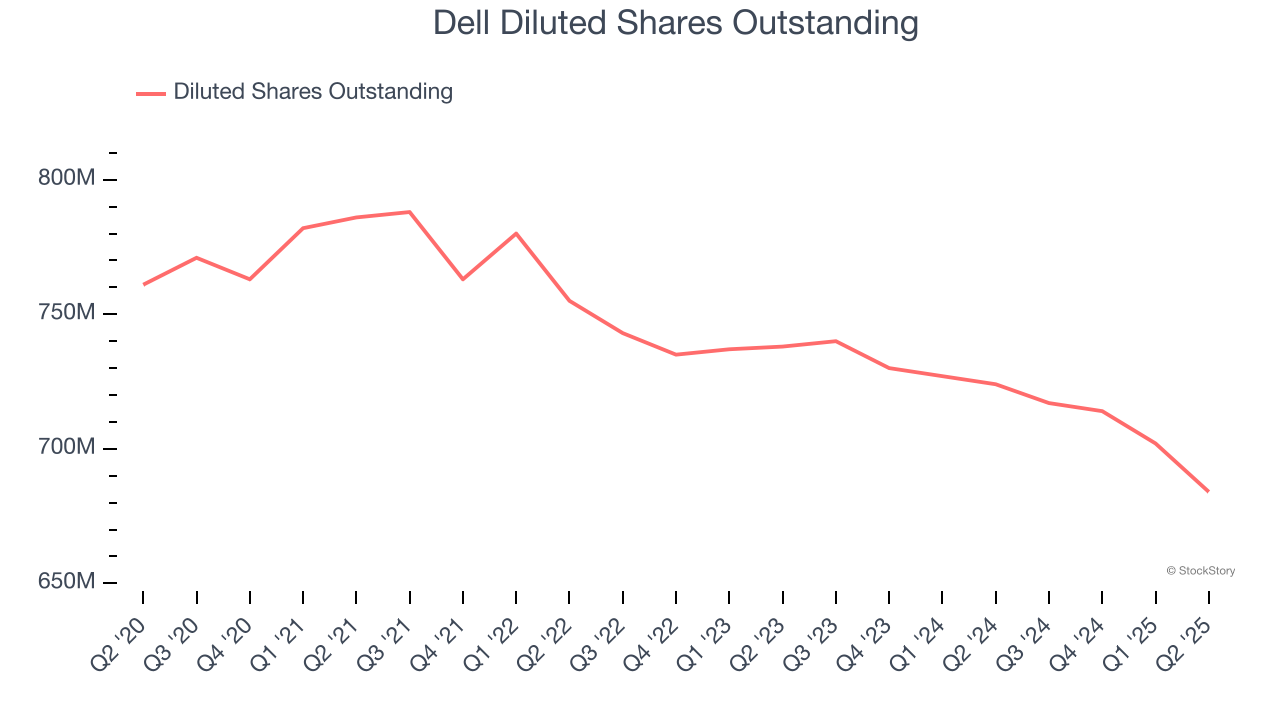
Like with revenue, we analyze EPS over a more recent period because it can provide insight into an emerging theme or development for the business.
For Dell, its two-year annual EPS growth of 10.4% was higher than its five-year trend. Accelerating earnings growth is almost always an encouraging data point.
In Q2, Dell reported adjusted EPS of $2.32, up from $1.89 in the same quarter last year. This print beat analysts’ estimates by 1.1%. Over the next 12 months, Wall Street expects Dell’s full-year EPS of $8.70 to grow 19.4%.
Key Takeaways from Dell’s Q2 Results
We were impressed by Dell’s optimistic revenue guidance for next quarter, which blew past analysts’ expectations. We were also glad its full-year revenue guidance exceeded Wall Street’s estimates. On the other hand, its EPS guidance for next quarter missed. Overall, this print had some key positives. Investors were likely hoping for more, and shares traded down 4.5% to $128.45 immediately after reporting.
Should you buy the stock or not? If you’re making that decision, you should consider the bigger picture of valuation, business qualities, as well as the latest earnings. We cover that in our actionable full research report which you can read here, it’s free.







